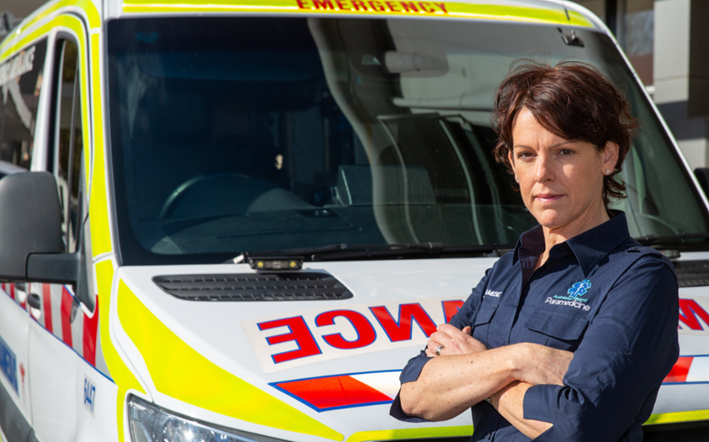Story from Insightplus, The Medical Journal of Australia
Health system reform must involve paramedics
Written by Michelle Murphy ASM, Advocacy and Government Relations Lead at the Australasian College of Paramedicine

Despite increasing consensus among many representative health bodies of the need for reshaping the health landscape, governments need to do more to support team-based models of care, including involving paramedics.
In recent months, national and state governments in Australia have increasingly supported the adoption of multidisciplinary, team-based models of health care to improve health service access and delivery in communities and ease the growing burden on the nation’s hospitals and ambulance services.
Most recently, this has been highlighted by the Strengthening Medicare Taskforce Report.
This reconceptualisation of the health landscape and the manner in which we deliver out-of-hospital and primary health services, particularly to communities of need in regional and remote areas of the country, represents a transformational shift for the health sector (here and here). Importantly, it paves the way for more integrated health services, using the skills and capabilities of different health workforces, including paramedics, to provide more accessible and equitable health care.
The willingness of governments to embrace sectoral innovation reflects the current state of the health system. According to the Commonwealth Fund, Australia is one of the top-ranking countries overall for health care but is the third lowest ranked for access and second lowest ranked for health care spending as a percentage of the gross domestic product — a deterioration in access to health care from 2017 (ranked fourth, now ranked eighth out of 11).
The challenges are both complex and intersectional, encompassing distance, geography, and the maldistribution of qualified medical practitioners. Health workforce shortages, the lack of access to health services in many parts of the country, and fewer beds available in hospitals have resulted in a rise in presentations to emergency departments (EDs) and ambulance call-outs for non-life-threatening injuries that could be best managed in primary and urgent health care settings.
According to Australian Institute of Health and Welfare (AIHW) data, in 2021–2022 there were 8.79 million presentations to EDs in Australia — a rate of 339 per 1000 population — of which 46% were for people aged between 25 and 64 years. Overall, in the past five years, emergency presentations have experienced an average annual increase of 2.3% per year.
A 2017 study found that 10–37% of adults and 41–51% of children presenting to EDs were cases that could be managed in the community. Providing care to these patients in the community through multidisciplinary Medicare Urgent Care Clinics (MUCCs) and medical practices has the potential to deliver substantial savings to the health system in the costs associated with emergency presentations, the management of chronic health conditions, and early entry into aged care.
Indeed, a growing number of urgent care centres are being established throughout Australia in an attempt to ease the pressures on hospital EDs by reducing the number of urgent and semi-urgent presentations while also increasing access to primary care (AIHW-reported ED presentations: urgent 39%, semi-urgent 36%, and emergency 15%), providing an opportunity to incorporate MUCC referral pathways into sustainable emergency medicine workforce models of care.
Despite increasing consensus among many representative health bodies of the need for a reshaping of the health landscape and growing support for team-based models of care, little elaboration has yet been forthcoming on the Australian Government’s vision of what multidisciplinary, team-based care looks like, how it will operate, the health workforces to be used, the policy and legislative reforms that will be required, and the big question: how it will be funded.
This lack of substantive detail was also evident in the federal government’s Strengthening Medicare Taskforce Report released in February, which emphasises the need for “coordinated multidisciplinary teams of health care professionals work to their full scope of practice to provide quality person-centred continuity of care”. It’s undeniably an admirable objective in addressing the myriad health system challenges being faced; however, we remain in the dark as to workforce composition and distribution, and practice structure and functionality, all of which require greater consultation and collaboration with other health disciplines, including paramedicine. It’s equally important to acknowledge that MUCCs are not an all-encompassing panacea that will single-handedly remedy the existing inequities and workforce and health service shortages in many parts of the country, but if sufficiently inclusive of a range of clinicians, they are a model of how we can all work together to improve public health.
The need for such systemic reform is abundantly clear. In terms of health equity, the current primary health care system has not evolved to meet the growing needs of the population and has limited ability to meet the challenges of caring for the Australian community. This is particularly evident in rural and regional areas where people experience poorer health outcomes, lower life expectancy, and higher levels of disease and injury due to inadequate access to health services, and for poorer Australians who are twice as likely to have multiple chronic diseases than the wealthy.
As the peak representative body for paramedics throughout Australasia, the Australasian College of Paramedicine has been advocating with governments for the broader integration of paramedics across the health system, working as part of multidisciplinary teams alongside GPs, nurses, and other allied health professionals. From our experience, it is a model of health care that we know works; is sustainable and cost-effective; eases pressure on ambulance services, hospitals and GPs; and greatly contributes to overall improvements in public health access and delivery.
Paramedics are already working in the community, in medical practices and health clinics, in palliative and aged care, in mental health, in private sector industries, and in caring for people in their homes to reduce unnecessary hospital stays. They treat a wide variety of patient presentations, from the critical and urgent through to acute chronic conditions experienced every day by a growing percentage of the population. And they’re working across both primary and tertiary care, after hours, on weekends and on public holidays, and are the only profession that provides an emergency and community care safety net in cities, regional areas and remote Australia.
Paramedicine is also the fastest-growing health profession at 9% year-on-year for the past four years. Paramedics, together with their colleagues in allied health disciplines, are ideally placed to support the traditional primary care workforce and provide more comprehensive, holistic and timely health care for our communities.
The shift from siloed professions to team-based care is the future of health care in Australia, and was recognised as such in the Grattan Institute’s 2022 A new Medicare: strengthening general practice report that envisioned general practice becoming a “team sport”, with clinicians from a range of disciplines sharing the load under the leadership of GPs. Paramedics are an integral component of that vision and were identified as among the clinicians for whom there is “a very significant gap between the contribution they are able to make, and what funding and policy let them do in Australia”.
Team-based practice was also championed in the recent Ngayubah Gadan (Coming Together) consensus statement on rural and remote multidisciplinary health teams from the Office of the National Rural Health Commissioner. The statement proposes a codesigned model of team-based care that will help deliver improved health outcomes for communities and that enables those communities to tailor sustainable and affordable health services to their individual needs.
Under this new model, paramedics will join other health professions as part of Rural and Remote Multidisciplinary Health Teams (RRMHTs) alongside clinicians from nursing, medicine, allied health, Aboriginal and Torres Strait Islander Health Workers and Practitioners, dentistry, psychology, pharmacy and midwifery. The initiative is premised on the understanding that local determination of health services and the codesign of models of care with communities ensures the appropriateness, acceptability and suitability of context-specific health services.
Importantly, it recognises that there is no one-size-fits-all model of multidisciplinary health care, and that communities are best served when they are able to articulate their needs and collaboratively design models of care that meet their health and wellbeing needs, including workforce composition, to ensure the best possible place-based care.
The future of our nation’s health will be shaped by these new models of team-based care. However, for this vision to become a reality, it must be supported by commensurate policy and legislative changes, particularly to the Medicare Benefits Schedule.
Changes are also needed to current policy to provide access to workforce incentive programs, including relocation, training, and remote/rural packages, for health workers wanting opportunities to bridge the gaps in the health system and workforce shortages in regional and rural areas across the country.
National and state governments are moving in the right direction and laying the groundwork for a new era of health care, but there is still much to be done in terms of cross-sector collaboration, requisite investment, and the development of accompanying policy frameworks to bring this to fruition. Every discipline has a role to play, and each of us must be a part of the solutions.
Read the article at Insightplus

Get unlimited access to hundreds of ACP's top courses for your professional development.
Join Now